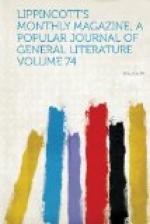There are principles of toxicology which ought to have legal force and recognition, and ought to govern expert testimony in the same way that the principles of evidence govern ordinary testimony. Without presuming to enumerate these, I will cite two or three for illustration. Certain substances, the so-called irritant poisons, such as arsenic, tartar emetic and the like, induce their toxic effects by causing irritation and inflammation of the alimentary canal. All authorities agree that poisoning by these substances cannot be proved, or even rendered, very probable, by symptoms alone—that chemical evidence, the discovery of the poison in the food, dejections, or in case of death the body, is absolutely essential for making out a case. Irritation and inflammation of the alimentary canal occur so often and so suddenly from natural causes, which are sometimes apparent, but often hidden, that no especial weight can be attached to them.
In the case of the so-called neurotic poisons, those which act upon the nervous system, the symptoms are so closely simulated by natural disease that even when they agree in the most absolute manner with those usually developed by any such poison they only render poisoning highly probable, not certain.[15] When in any case the symptoms diverge from the typical array, poisoning becomes improbable just in proportion to the amount of divergence.
All toxicological authorities also agree that in the case of the metallic poisons, such as tartar emetic and arsenic, the metal must be brought into court, and that the so-called “color tests” are not to be relied on. When sulphuretted hydrogen is passed through solutions of these metallic substances colored precipitates are thrown down, which at one time were thought to be absolute proof of the existence of the poison in the original solution. But in the celebrated Donnal case, tried at Falmouth, England, in 1817, Dr. Neale saved the accused by showing that a decoction of onions, of which the deceased had eaten a short time before death, yielded similar precipitates to those relied upon by the prosecution as establishing the presence of arsenic in the stomach. In regard to tartar emetic, Dr. Taylor, in his work on medical jurisprudence, says: “Antimony in the metallic state is so easily procured from a small quantity of material that on no account should this be omitted. A reliance on a small quantity of a colored precipitate would be most unsatisfactory as chemical evidence.” In defiance of all the authorities the prosecution, on the trial of Mrs. Wharton for the murder of General Ketchum, rested its proof of poison upon these color tests and their sequences. The defence, however, found that the counterparts of three out of the four so-called characteristic reactions were readily performed with the substances known to have been in the stomach of General Ketchum at the time of his death.
Several cases of poisoning which have been tried recently in this State and Maryland have attracted much attention, and I propose now briefly to outline these, and show that the disgraceful scenes which have taken place were not due to deficiencies of toxicological science, but to the causes already spoken of.




